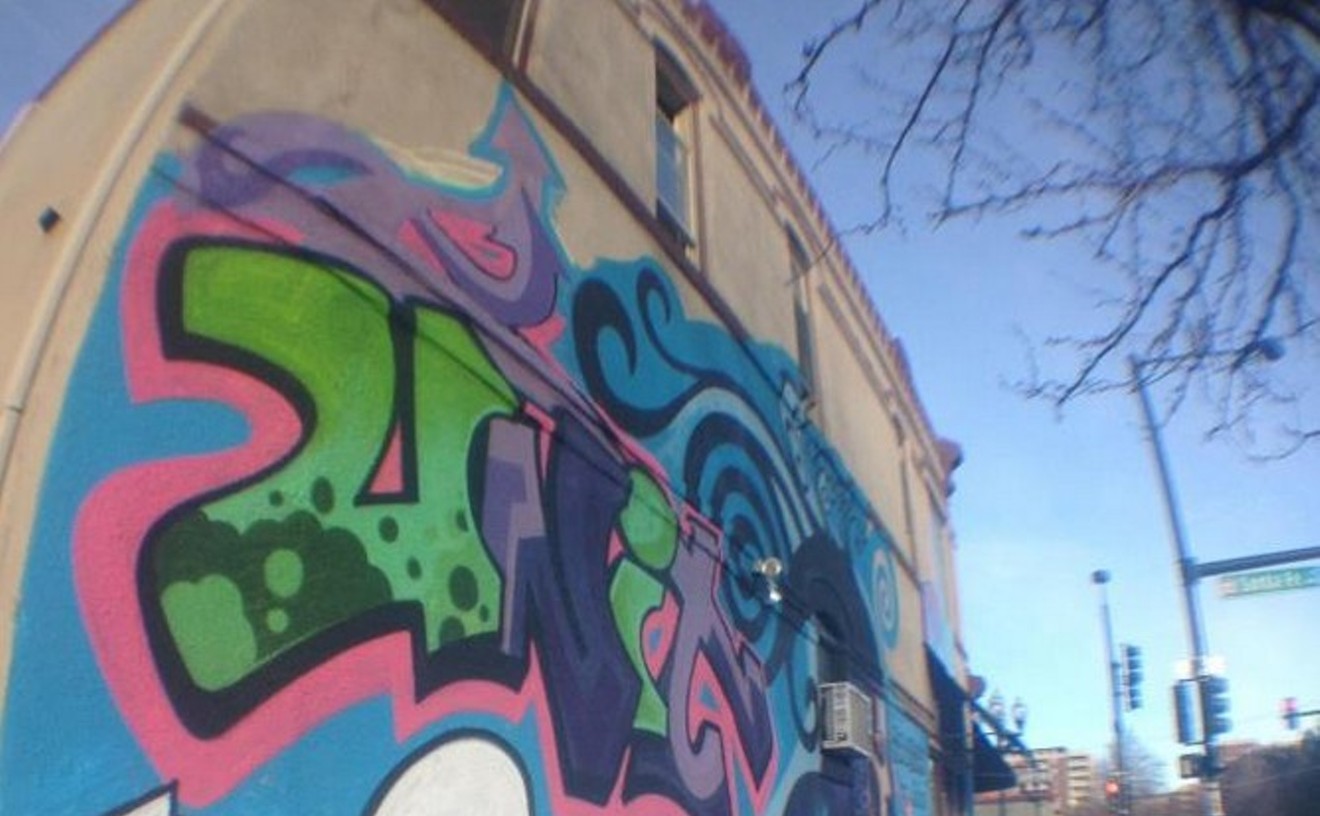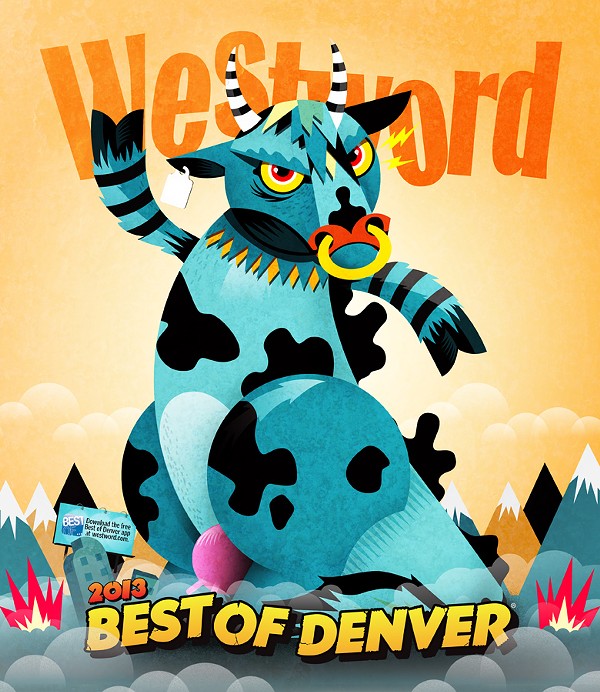"Mustang," a 32-foot-tall blue fiberglass stallion with glowing orangey-red eyes, has truly captured the public's attention. The piece conflates the Wild West with lowrider culture and is the greatest accomplishment of its creator, the late Luis Jiménez. When it was unveiled in early 2008, fifteen years behind schedule and two years after a chunk of the then-work-in-progress had fallen on Jiménez and killed him, it generated cheers from some and jeers from many more. This past February, the sculpture turned five years old, which meant the city could start considering any official requests that it be moved — or dumped altogether. But the issue turned out to be a non-starter, because "Mustang" has only gained popularity over the years. Even some of its most vehement detractors have come around. Hold your horses!
Best Radio DJ
Alisha Sweeney
Open Air debuted on Halloween 2011 at the frequency formerly occupied by the legendary KCFR, and the Colorado Public Radio-affiliated station has since established itself as one of the most free-spirited stations around. Its popularity is due not only to its programming, but also to its on-air personalities. The best among them is Alisha Sweeney, whose morning show features a well-curated mix of alternative, indie and classic artists, from Feist and New Order to David Bowie and Brian Eno, that would appeal to anyone. And her banter between songs is just as charming as her selections.
Best Reality-TV Star From Colorado
Dog the Bounty Hunter
Long before he was a reality-TV star, Duane Chapman was a bounty hunter based in Denver — and he even won an early Best of Denver award, for his work on the mean streets of this city. Since then, of course, he's gone on to much bigger and better things. And although he and A&E parted ways over his successful Dog the Bounty Hunter series last year, he and his wife, Beth, have been staying plenty busy. This March, they guest-starred — as themselves — on Hawaii Five-0. And they have a new series starting, with son Leland, in April; Dog will be helping struggling bail bondsman companies across the country — and, as always, taking down dangerous criminals. This Dog still has plenty of bite.
Best Redefinition of Western Art
Ed Ruscha: On the Road
With Denver being a key stop in Jack Kerouac's On the Road, Colorado found its place on the hipster map. Los Angeles-based conceptualist Ed Ruscha, himself a hipster's hipster, did a series of works on paper that incorporated quotes from the novel and placed them across photos of Western landscapes or related abstracts. They're classic post-pop Ruschas, with the text floating at the surface and the image receding behind it. Ruscha's work has been exhibited in Denver many times before, but here it was recast as Western art, simply by having been installed in the Denver Art Museum's Western art galleries. Indeed, curator Thomas Smith pulled off a sleight of hand, furthering an idea that's been catching on in the last few years: that by working in the West, Ruscha is just as Western as Frederic Remington was.
Best Relentless DIY Venue
Unit E

Unit E was shut down briefly last year when the cops took issue with the venue's donation-only bar. But that didn't stop the unassuming multi-purpose space from thriving. Once co-habitant Gregg Ziemba took care of the resulting fines, he and the rest of the collective went back to work. Delivering on the group's mission to bring art together with punk, hip-hop, noise, folk, funk and everything in between in an all-ages environment, Unit E hosts some of the most diverse local shows around. Biding its time until the legal issues subside, Unit E continues to serve the Santa Fe Arts District as a place where kids can see local and national touring bands in the midst of Denver's burgeoning art scene.
- 1201 Santa Fe Dr., Denver, 80204 Map
- 720-936-6074
- www.unit-edenver.com
Best Reminder of an All-But-Forgotten Artist
William Joseph: Sculptor & Painter
A small private venue in Capitol Hill, the Kirkland Museum has done more to preserve and promote the history of Colorado art than any other museum in the state. In fact, it could be said that the Kirkland, under the direction of Hugh Grant, has done more on this score than all of the other museums combined. One of its specialties is resurrecting the work of deceased and fairly forgotten artists, and that's just what the excellent William Joseph: Sculptor & Painter did. Put together by Grant and deputy curator Christopher Herron, the show revealed Joseph's lifelong interest in the figure, which he abstracted in order to come up with his signature style. Best known as a sculptor, with a number of works prominently placed downtown, Joseph also made paintings, which are every bit as good.
Best Retrospective
Floyd D. Tunson: Son of Pop
As a kid in Denver in the '60s, Floyd Tunson would flip through the magazines his mother brought home from her job as a housekeeper, paying particular attention to the work of the pop artists, notably Warhol. It changed his life, and Tunson has been responding to it in his work for the past thirty years, though he takes on racism rather than consumerism. Last winter, Blake Milteer, the museum director at the Colorado Springs Fine Arts Center, mounted one of the best retrospectives ever for a contemporary Colorado artist with Floyd D. Tunson: Son of Pop. The stunning, sprawling show was a fitting tribute.
Best Return to the Denver Music Scene
Sleepers
In the second half of the '90s and the early part of the '00s, Kathryn Ellinger was one of the primary songwriters in experimental rock band Worm Trouble. The charismatic frontwoman, a multi-instrumentalist with a strong yet girlish voice, had a knack for crafting pop songs with avant-garde underpinnings. Ellinger renamed the band Sleepers around 2003, and focused on songwriting that was no less diverse, but heavier in terms of instrumentation. Worm Trouble and Sleepers both garnered a good deal of critical acclaim, but Ellinger found it necessary to take an extended break from the world of music. Five years later, a reinvigorated and newly inspired Ellinger has returned, along with her pronounced ability to write songs that ignore any divide between conventional and outsider aesthetics.
Best Reunion Show
Five Iron Frenzy
When ska was ascending to the peak of its popularity, Five Iron Frenzy was in the right place to ride that wave. There was a glut of ska in the '90s, and before Five Iron broke up, what set it apart was the fact that it was punk and rock as much as it was ska. It was also a thoroughly non-judgmental Christian band, and the music it wrote was legitimately good. Plus, the band was genuinely funny, and its relationship with fans was one based on real human connection. All of this earned the group admirers wherever it played. When Five Iron announced it was getting back together, expectations were high, and while the New Year's Eve show at Casselman's may not have been as frantic as in the past, the performance was vibrant, fun and endearing in a way that few ever are.
Best Reunion That You Probably Missed
Uphollow at Wax Trax
Some of the best shows are the ones that no one seems to see — and this was definitely the case for Uphollow's original-lineup reunion last April. As part of the Wax Trax 33 1/3 Birthday Blowout — set over Record Store Day weekend — the band came together for an amazing revival of its pop-punk past. Uphollow's post-'90s incarnations took the group to new heights: a conceptual double album, Soundtrack to an Imaginary Life, the multimedia collaboration Jackets for the Trip and the welcome addition of Ian Cooke all added to its dynamism and continued growth. The Wax Trax show might have only been half full — but it meant the world to the collection of fans who were there to see the band step back in time, in all its Mission to the Moon-era glory.





